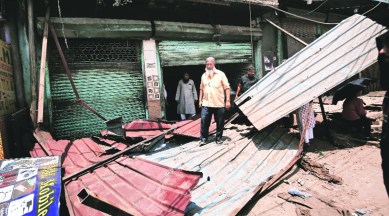Stay updated with the latest - Click here to follow us on Instagram
Jahangirpuri demolition: Why civic body action raises question marks over due process
The Delhi Municipal Corporation Act 1957 states that the civic body needs to give at least five days’ notice to a person who has carried out the alleged illegal construction.

Wednesday’s action in Jahangirpuri by the North MCD flies in the face of its usual practice of sending a notice at least five days in advance in cases of encroachment.
The Delhi Municipal Corporation Act 1957 states that the civic body needs to give at least five days’ notice to a person who has carried out the alleged illegal construction. During this time, the person can be asked to make alterations, failing which the corporation has the power to demolish or seal the unauthorised structure.
monthly limit of free stories.
with an Express account.
“Where the erection of any building or execution of any work has commenced or has been carried out, or is being completed… in contravention of any of the provisions of the bylaws, the commissioner may make an order directing that such erection work shall be demolished by the person at whose instance the work has been carried, not being less than five days from the date on which a copy of the order of demolition with a brief statement of the reasons has been delivered to the person,” reads the Delhi Municipal Corporation Act 1957.
While this is the case of unauthorised construction on private land, in case of public land, the corporation has extended jurisdiction. The Act states that the commissioner may, without notice, remove any “stall, chair, box, ladder or other things whatsoever placed, deposited, projected attached or suspended. Secondly, any article placed whatever hawked or exposed for sale on any public street or in other public place in contravention of this act, and vehicle, package box or any other thing on which such article is placed”.
Officials said it is this rule that the corporation has used in case of Jahangirpuri to carry out a demolition exercise which is bigger in nature than is generally carried out on footpaths and roadsides, senior officials from Delhi’s three civic bodies said.
Structures demolished in Wednesday’s drive include the outer gate of a mosque, vending carts, the concrete extension of a juice corner, and the staircase of a household.
“The notice has to be issued for permanent construction, not for temporary construction. In this case we have not touched any permanent construction,” said Ankita Mishra, deputy commissioner of Civil Lines Zone, when asked about Wednesday’s action.
Another official of the SDMC, who was part of the special task force constituted to clear encroachments in the city by the DDA, said that such drives, where notices are not served, have in the past largely been limited to roadside stalls or temporary sheds. “If we demolish a concrete structure like a juice shop or conduct demolition near a religious place, due process of serving notice is followed,” said the official.
Another North body official said it is surprising to see the force in such large numbers — more than 1,000 personnel were deployed on Wednesday — being provided by the police on such short notice. The corporation used four bulldozers, eight trucks and four small trucks to clear the 2-km stretch near Kushal Cinema.
North MCD Mayor Raja Iqbal Singh, when contacted, said there was no need to send notices as the drive was mainly to clear traffic and remove sacks of waste being kept on the road. Asked about the outside gate of a mosque being demolished, he said, “I am not aware of the masjid gate, and in the case of the juice corner, only the extension has been demolished.” He said the action should not be linked to communal clashes four days ago as similar drives have been carried out earlier too.
The civic body’s continued action despite the Supreme Court ordering a “status quo” at the site also raises questions.
In a 1987 ruling in Vinod Kumar Singh vs Banaras Hindu University & Others, the Supreme Court had held: “When a judgment is pronounced in the open court, the parties act upon it and conduct their affairs on the basis that it is in judgment of the court and that the signing of the judgment is a formality to follow. A judgment to be operative does not await the signing thereof by the court. If what is pronounced in the court is not acted upon, the litigants would be prejudiced; their confidence in the judicial process would be shaken. A judgment pronounced in the open court should be acted upon unless there be some exceptional feature, like, soon after the judgment is declared in the open court, a feature, not placed for consideration before the court earlier, is brought to its notice by either party to the cause, or the court discovers some new facts from the record or the court notices a feature, which should be taken into account, or a review is asked for, which is granted. In such a situation the court may take up the matter again for further consideration, and it has to give good reasons if the judgment delivered by it is not to be operative.”